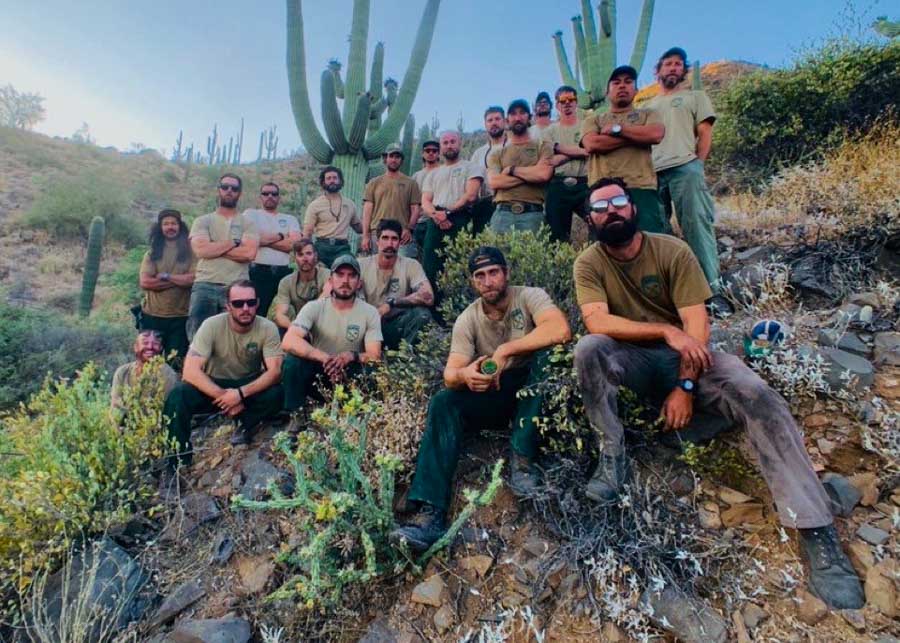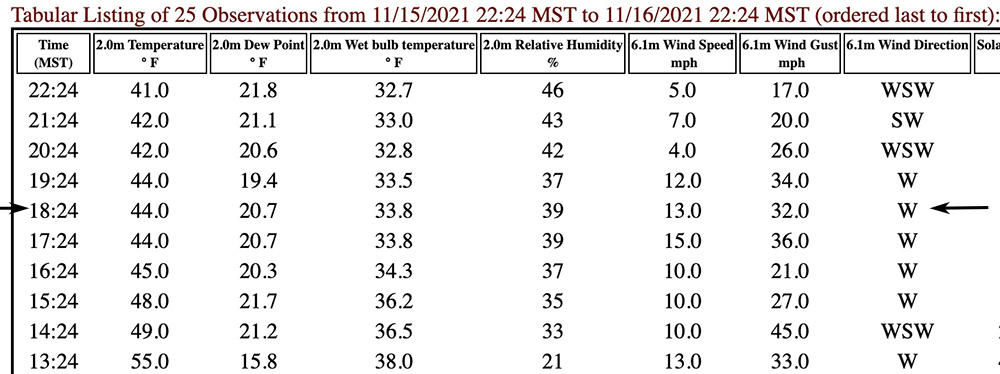
The U.S. Forest Service produced this video about the 2021 wildfire season of a fire crew based on the Six Rivers National Forest in Northern California — the Smith River Interagency Hotshots.
News and opinion about wildland fire
Smith River Interagency Hotshots

The U.S. Forest Service produced this video about the 2021 wildfire season of a fire crew based on the Six Rivers National Forest in Northern California — the Smith River Interagency Hotshots.

John Hawkins, retired CAL FIRE Unit Chief and County Fire Chief, sent us a .pdf copy of the publication, Forest Fire Fighting Fundamentals, which I had not seen in many years. It may have been considered part of basic training for wildland firefighters, written by the US Forest Service and the agency then known as California Department of Forestry (CDF).
I’m not sure when the 58-page document was first published. As you can see above, it was received on the Medicine Bow National Forest in 1953. The National Museum of Forest Service History says it was published around 1945 (“1945 ca.”), but I wonder if there were multiple editions throughout a couple of decades.

There are many hand-drawn illustrations, many of which are attention-grabbing or funny, which may have made it easier to retain the lesson being taught.

There are no chain saws or air tankers, but you will see a dozer and a very early model helicopter. Numerous times it mentions “men” being used to fight fire, “Only physically fit men should be used,” for example.

It mentions aggressive initial attack, saying that when using direct attack, “You either ‘hit the head’ (point of most rapid spread) or start at the rear and work forward on both sides (flanks) at the fire edge and thus pinch out and control the head.”

It is very out of date in many respects, but the physics of fire and general principles of fire suppression and firefighter safety remain basically the same. It has been a while since I looked at what rookies are shown in basic firefighter training, S-130/190, but it would not hurt to let them peruse this document to help reinforce some fundamentals.
You can download the 2.3 MB document.
Folsom Lake Veterans, a Type 2 Initial Attack Crew

By Jennifer Myslivy & Erin McDuff
It just makes sense to match our veterans’ skills with wildland firefighting. From teamwork to decisive leadership; risk mitigation to management; logistics to emergency medicine, many of the skills our veterans learned in the military translate to wildland firefighting.
The Bureau of Land Management launched a Veteran Fire Crews program in 2012 to provide more jobs for veterans while benefiting from their vast experience and increasing the number of wildland firefighters available during our increasingly severe wildfire seasons.
 The Folsom Lake Veterans’ Crew in California combines military veterans with seasoned wildland firefighters to form this type 2 initial attack hand crew, which is responsible for constructing fire lines while also capable of separating into smaller squads to conduct initial wildfire suppression activities.
The Folsom Lake Veterans’ Crew in California combines military veterans with seasoned wildland firefighters to form this type 2 initial attack hand crew, which is responsible for constructing fire lines while also capable of separating into smaller squads to conduct initial wildfire suppression activities.
This crew provides an opportunity for veterans to learn about the wildland fire management field and gain critical skills that will prepare them for a full career in wildland firefighting.
Meet Conell McKinney

An Army veteran from Santa Clarita, California, Conell McKinney served in the infantry.
He now works as a wildland firefighter with the Folsom Lake Veterans’ Crew. “The self-discipline the Army instilled in me helped quite a bit with my transition to wildland firefighting and with understanding how to operate in less-than-ideal environments,” he explained.
The advice he would like to share with others that may be interested in wildland firefighting is, “Train hard. The work is like nothing you’ve done before!”
Meet Roger Hooper

During the 2021 fire season, the Folsom Lake Veterans’ Crew trained 200 active-duty Army soldiers stationed at Joint Base Lewis-McChord who were dispatched to assist with wildfire suppression operations.
Roger Hooper, a crewmember and infantry veteran from Nevada City, Nevada, noticed many military skillsets that helped the soldiers transition in firefighting, including hard work, discipline, the ability to stay calm in complex situations, teamwork, and resource management.
When asked for advice for those interested in wildland firefighting, Hooper said “Maintain good physical shape and apply for a variety of fire jobs because there is one out there that you will enjoy!”
Meet Jaime Velasquez
Jaime Velasquez is a crewmember from Sacramento, California. He’s a veteran of the National Guard and served as a water purification specialist. He came to the Bureau of Land Management with prior firefighting experience from when his National Guard unit was activated by the state to fight wildfires in 2014.

During the Joint Base Lewis-McChord deployment this season, Velasquez enjoyed seeing how motivated they were to learn the job and the opportunity to hear some of their stories and experiences.
Firefighting Job Opportunities for Veterans
Are you a veteran, or do you know a veteran, who is looking for a new, exciting career? For anyone who wants to work in a field that is physically and mentally challenging, gets you outdoors, provides opportunities for travel, delivers occasional spikes of adrenaline, and serves the greater good, wildland fire checks a lot of boxes and can benefit from the expertise of veterans.
The Interior Department is hiring to fill hundreds of wildland fire management jobs this fall. The positions are located throughout the country, and more are posted on usajobs.gov each day.
You can learn more about working in wildland fire on our website. Before you start on an application, check out firejobs.doi.gov, along with these pro tips and video tutorials on how to apply.
We promise, it’s not your ordinary job!

Jennifer Myslivy is a public affairs specialist with the Bureau of Land Management at the National Interagency Fire Center in Boise, Idaho.
Erin McDuff is a public affairs specialist with the Office of Wildland Fire.
4:42 p.m. PDT Nov. 18, 2021

The Acting Air Tanker Base Manager of the base at the San Bernardino Airport in Southern California died Saturday November 13. Edward Godinez was 32 and passed away from COVID-19 after spending three weeks in an ICU. He had recently been selected to serve in that role permanently.
Fire Aviation has learned that Mr. Godinez had not been vaccinated and that several other unvaccinated Forest Service employees at the base also tested positive for COVID.
May Mr. Godinez rest in peace.

A federal grand jury returned a five-count indictment November 18 against Gary Stephen Maynard, 47, of San Jose, charging him with arson to federal property and setting timber afire, Acting U.S. Attorney Phillip A. Talbert announced.
According to court documents, Maynard engaged in an arson spree in the vicinity of the then ongoing Dixie Fire in areas of the Shasta-Trinity and Lassen National Forests. Some of the fires he set were new fires behind the firefighters fighting the Dixie Fire. Maynard is charged with setting the Cascade Fire (July 20), Everitt Fire (July 21), Ranch Fire (Aug. 7), and Conard Fire (Aug. 7).
He was not charged with starting the Dixie Fire, but was investigated for his responsibility in starting five others. They were all suppressed before growing large, in part because for some of them his vehicle was being tracked and after obtaining warrants arson investigators had access to the approximate location of his cell phone every 15 seconds. In a couple of cases US Forest Service Agents reported the new fires immediately, were the first on scene, and did what they could to knock down the blazes until firefighters arrived.
Mr. Maynard is a former instructor at universities in California including Santa Clara and Sonoma State.
From CNN:
Maynard was a part-time lecturer at Sonoma State University in its Department of Criminology and Criminal Justice during the fall of 2020, a university spokesperson told CNN. He taught two seminars on the topics of criminal justice and deviant behavior, according to school officials. Maynard was filling in for a faculty member who was on leave and was not reappointed for Spring 2021, the school spokesperson said.
Sonoma State University welcomed him as a new lecturer on August 31, 2020. Their description:
Dr. Gary Maynard graduated from Bowling Green State University, University of Alaska Fairbanks and Stony Brook University. He has three master’s degree (political science, theater arts, and sociology) and a Ph.D. in sociology. His teaching and research focus on the following topics: sociology of technology/social media, social psychology, sociology of health, deviance and crime, sociology of the mass media, youth and adolescence, global sociology, environmental sociology, the sociology of sports, the sociology of drug abuse and alcoholism and quantitative research methods.
More information about the four fires is in our August 11, 2021 article.
Pilot Marc Thor Olson was killed
1:59 p.m. MST Nov. 18, 2021
This article was first published at Fire Aviation.

Around the time Single Engine Air Tanker 860 crashed at the Kruger Rock Fire in Colorado at approximately 6:36 p.m. MST on November 16, killing pilot Marc Thor Olson, the Estes Park ESPC2 Remote Automatic Weather Station recorded sustained winds of 13 mph gusting to 32 mph out of the west. The station is 3.7 miles northwest of the fire at 7,892 feet and its anemometer is 20 feet above the ground.

Looking at the flight tracking log from FlightAware above, the wind appeared to be much stronger at the plane’s altitude, which was 8,950 to 10,450 feet while it was over the fire. The highest peak just south of the fire is at 9,400 feet.

As it made four orbits near the fire during the 10 minutes it was in the area, the ground speed of T-860, an Air Tractor 802A (N802NZ) varied from a low of 82 mph while flying west to a maximum of 200 mph when east-bound. These shifts in ground speed were consistent during all four orbits. This indicates a very strong wind out of the west, a direction that is consistent with the data from the weather station.

There are two reasons that fixed wing air tankers avoid attacking wildfires during strong winds. One, the wind makes it difficult or impossible for the retardant to hit the target, getting blown horizontally as it falls from the aircraft to the ground. Second, flying low and slow, as air tankers have to do, is difficult in mountainous terrain with calm winds, but it can be extremely hazardous during strong winds.
When you add a third complexity of dropping at night using night vision goggles, something that has been done very little in the history of aviation, and never before in Colorado, the pilot had the deck stacked against him. The chances of stopping or slowing the spread of the fire with retardant, water, or any other suppresant, were very, very slim. (There is a report that the operator of the aircraft, CO Fire Aviation, experimented with night drops in Oregon in 2020 and 2021.)
NEW: CO Fire Aviation confirms the pilot killed in the air tanker crash last night was Marc Thor Olson. He told me most people called him Thor.
This is a picture I took of him last night as he was prepping his plane. The crash happened about an hour later #9News pic.twitter.com/uEOO4tbXwK
— Marc Sallinger (@MarcSallinger) November 17, 2021
The weather forecast available from the National Weather Service that Tuesday afternoon called for continued very strong winds until sundown and a chance for snow Tuesday night. It predicted dry weather on Wednesday and Thursday with high temperatures in the 30s and 40s under mostly sunny skies with the relative humidity around 20 percent. The wind chill was expected to be below zero from Wednesday afternoon until Thursday afternoon. The actual low temperature Tuesday night turned out to be 11 degrees.
Risk vs. reward
With 20/20 hindsight looking at risk vs. reward, this was a very high risk mission. The potential reward was little, considering the likely effectiveness of 700 gallons of suppressant blown off target by strong winds and the weather forecast of a chance of snow in a matter of hours and wind chills the next day below zero.
Who decided to attempt the night flight?
The short answer is, the Larimer County Sheriff’s office ordered the aircraft to respond to the fire, using a “verbal call when needed contract”, an arrangement that was first agreed to on October 5, 2021.
A preliminary map appears to show that the fire was just inside the boundary of the Roosevelt National Forest. The Larimer County Sheriff’s office said on Wednesday Nov. 17 that as of 7 a.m. that day the fire was being managed by a unified command with the US Forest Service and the Sheriff.
In Colorado, Texas, and Wyoming the local county sheriffs are given the responsibility for suppressing wildfires outside of cities unless they are on federal land. The Kruger Rock Fire was in Larimer County.
As Wildfire Today reported November 16, before the fatal flight, T-860 departed from the Fort Morgan, Colorado airport, orbited the fire about half a dozen times, then landed at Northern Colorado Regional Airport at 4:38 p.m. MST. This flight is listed in the image from FlightAware above as one of two flights that day for the aircraft. It turns out that on the first flight it dropped water on the fire, which the pilot reportedly described as “successful”. After it landed at Northern Colorado Regional Airport it reloaded with “fire suppressant” instead of water, and by 6:13 p.m. MST was airborne returning to the fire.
Sunset that day was at 4:44 p.m. MST. The air tanker disappeared from tracking at 6:35 p.m., about 1 hour and 49 minutes after sunset. Air tankers working for the U.S. federal government are allowed to drop only as late as 30 minutes after official sunset.
The Denver Post reported that CO Fire Aviation said in a statement, “There was no aerial supervision or lead plane required for the mission and weather and wind conditions were reported to be within limits of our company standard operating procedures.”
In the video below Juan Browne has strong feelings about this incident. Shortly after posting it, he wrote a comment saying, “GROUNDSPEED NOT AIRSPEED!”
Below is an excerpt from a statement released November 17, 2021 by the Larimer County Sheriff’s office:
Continue reading “A weather station recorded strong winds as air tanker crashed on Kruger Rock Fire”